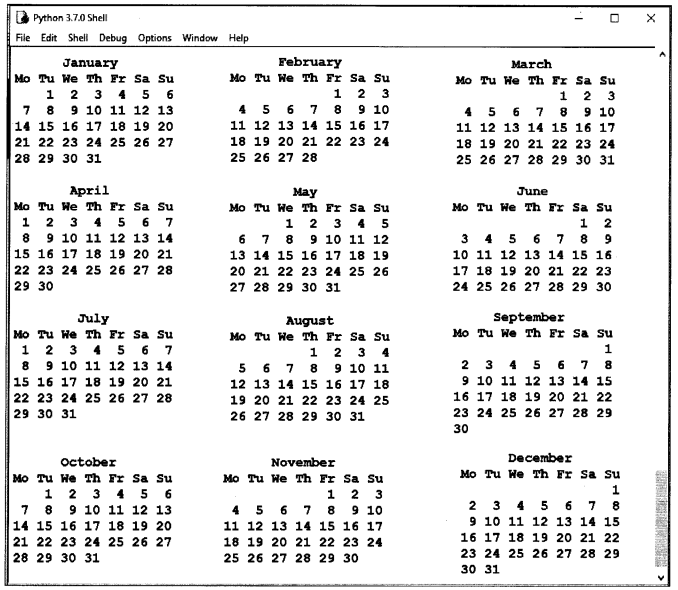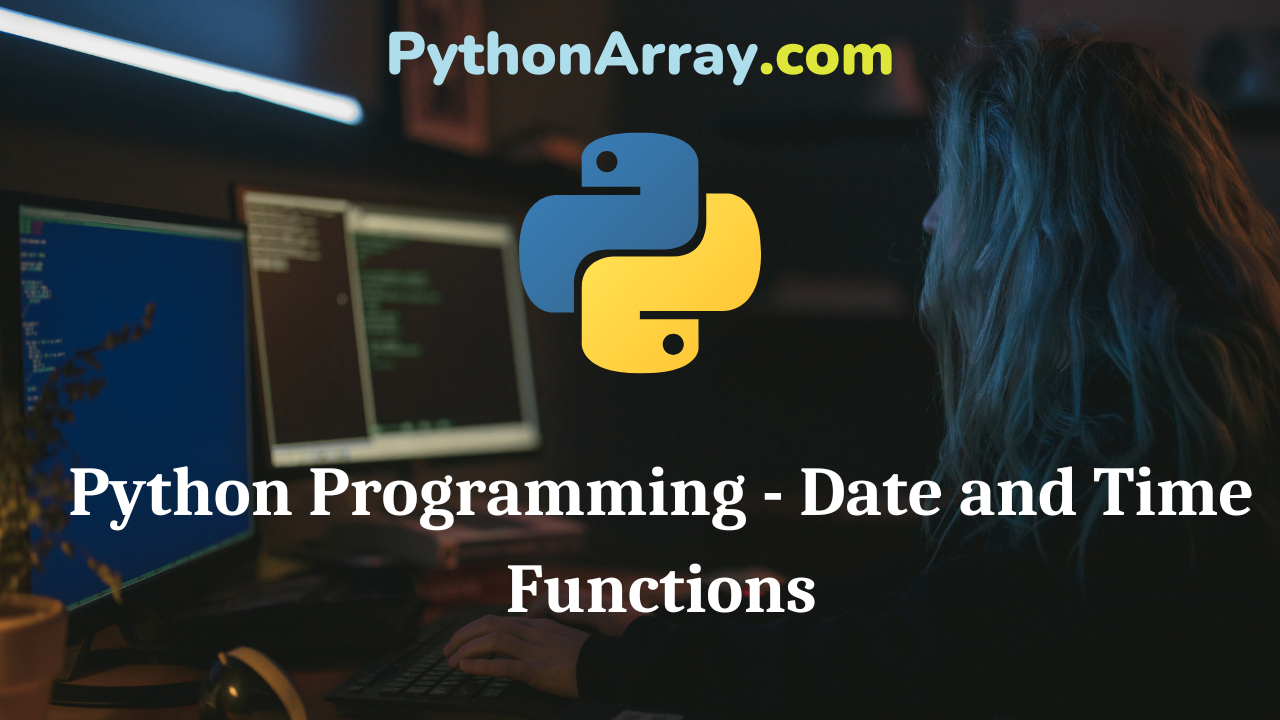You can learn about Functions in Python Programs with Outputs helped you to understand the language better.
Python Programming – Date and Time Functions
Classes provide a number of functions to deal with dates, times, and time intervals. Date and DateTime are an object in Python, so when you manipulate them, you are actually manipulating objects and not strings or timestamps. Whenever you manipulate dates or times, you need to import the DateTime function. The DateTime module enables you to create the cus¬tom date objects, and perform various operations on dates like the comparison, etc. To work with dates as date objects, you have to import the DateTime module into the Python source code.
The concept of Ticks
In Python, the time instants are counted since 12:00 am, January 1, 1970. It is the beginning of an era. and is used to start counting time. This special moment is called an epoch. In Python, the time between the present moment and the special time above is expressed in seconds. That time period is called Ticks. A tick can be seen as the smallest unit to measure the time. The time ( ) function in the time module returns the number of seconds from 12 am on January 1, 1970, to the present.
- Python Programming – Keywords/Reserved Words
- Python Programming – How To Start Python
- How to Display the Date and Time using Python | Python datetime module & strftime()
Example
Demo to calculate the number of ticks using the time ( ) function
| # Import time module import time# prints the number of ticks spent since 12 AM, 1st January 1970 ticks = time.time ( ) print (“Number of ticks since 12:00am, January 1, 1970: “, ticks)RUN >>> 1560653863.8000364 >>> |
time ( )
To get how many ticks have passed since the epoch, you call the Python time ( ) method.
>>> import time
>>> time. time ( )
1514472378. 761928
A time object instantiated from the time class represents the local time.
Example
Demo of time ( ) function.
| from datetime import time # time(hour = 0, minute = 0, second = 0) a = time ( ) print(“a =”, a) # time(hour, minute and second) b = time(9, 32, 52) print(“b =”, b) # time(hour, minute and second) c = time(hour = 9, minute = 32, second = 52) print(“c =”, c) # time(hour, minute, second, microsecond) d = time(9, 32, 52, 224565) print(nd =”, d)RUN >>> a = 00:00:00 b = 09:32:52 c = 09:32:52 d = 09:32:52.224565 >>> |
Example
Program to print hour, minute, second and microsecond.
| # Print hour, minute, second and microsecond from datetime import time a = time(9, 32, 52)print(“hour =”, a.hour) print(“minute =”, a.minute) print(“second =”, a.second) print(“microsecond =”, a.microsecond)RUN >>> hour = 9 minute = 32 second = 52 microsecond = 0 >>> |
Once you create a time object, you can easily print its attributes such as hour, minute, etc. Note that you have not passed the microsecond argument, so, its default value 0 is printed.
local time ( )
local time ( ) returns the current time according to your geographical location, in a more readable format. Consider the following example.
Example
Demo of localtime ( ) function.
| import time
#returns a time tuple print(time.localtime(time.time( ))) RUN |
asctime ( )
The time can be formatted by using the asctime ( ) function of the time module. It returns the formatted time for the time tuple being passed.
>>> import time
>>> time.asctime ( )
‘Sun Jun 16 11:18:09 2019’
clock ( )
It returns the number of seconds elapsed since the first call made to it. It returns the value as a floating number.
>>> time.clock ( )
1392.736455535
>>> time.clock ( )
1409.408693707
sleep ( )
The sleep ( ) method of time module is used to stop the execution of the script for a given amount of time. The output will be delayed for a number of seconds. Consider the following example.
Example
Demo of sleep ( ) function.
| import time for i in range(0,5): print(i) #Each element will be printed after 2 second time.sleep(2)RUN >>> 0 1 2 3 4 >>> |
now ( )
The now ( ) method to create a DateTime object containing the current local date and time. The date contains the year, month, day, hour, minute, second, and microsecond.
Example
Demo of now ( ) function.
| # Get Current Date and Time import datetime;#returns the current datetime objectprint(datetime.datetime.now())RUN >>> 2019-06-16 08:36:33.975566 >>> |
today ( )
today ( ) method defined in the date class to get a date object containing the current local date.
Example
Demo of today ( ) function.
| # Get Current Date
import datetime; |
Example
Demo of today ( ) function.
| # Print today’s year, month and day from datetime import date today = date.today ( ) print(“Current year:”, today.year) print(“Current month:”, today.month) print(“Current day:”, today.day)RUN >>> Current year: 2019 Current month: 6 Current day: 16 >>> |
date ( )
The date() is a constructor of the date class. It takes three arguments: year, month, and day.
Example
Demo of date ( ) function.
| # Date object to represent a date import datetime d = datetime.date(2019, 7, 12) print(d)RUN >>> 2019-07-12 >>> |
dir ( )
The dir ( ) function to get a list containing all attributes of a module.
Example
Demo of dir ( ) function.
| import datetime print(dir(datetime))RUN >>> [‘MAXYEAR’, ‘ M INYEAR’ , ‘ built ins ‘ , ‘ cached ‘ loader me_CAPI’, ‘ ‘, ‘ name ‘, ‘ package ‘, time’, ‘timedelta’, ‘timezone’ ‘ spec ‘, ‘ ‘tzinfo’] >>> |
timestamp ( )
You can also create date objects from a timestamp. You can convert a timestamp to date using from timestamp ( ) function.
Example
Demo of timestamp ( ) function.
| from datetime import date print(“Date timestamp)RUN >>> Date : 2021-07-14 >>> |
strftime ( )
The strftime ( ) method takes one or more format codes and returns a formatted string based on it. A reference of some format codes are used in following example:
Example
Demo of strftime ( ) function.
| import datetime x = datetime.datetime . now ( ) print(x.year) print(x.strftime(“%a”) ) #Weekday, short version i.e. Sun print(x.strftime(“%A”) ) #Weekday, full version i.e. Sunday print(x.strftime(“%w”) ) #Weekday as a number 0-6 i.e. 0 print(x.strftime(“%d”) ) #Day of month 01-31 i.e. 16 print(x.strftime(“%b”) ) #Month name, short version i.e. Jun print(x.strftime(“%B”) ) #Month name, full version i.e. June print(x.strftime(“%m”) ) #Month as a number 01-12 i.e. 06 print(x.strftime(“%y”) ) #Year, short version, without century i.e. 19 print(x.strftime(“%Y”) ) #Year, full version i.e., 2019 print(x.strftime(“%H”) ) #Hour 00-23 i.e. 11 print(x.strftime(“%I”) ) #Hour 00-12 i.e. 11 print(x.strftime(“%p”) ) #AM/PM i.e. AM print(x.strftime(“%M”) ) #minute 00-59 i.e. 02 print(x.strftime(“%S”) ) #second 00-59 i.e. 59 print(x.strftime(‘%c”) ) #Local version of date and time i.e. sun Jun 16 11 : 02 : 59 2019 print(x.strftime(‘”%x”)) #Local version of date i.e. 06/16/19 print(x.strftime(“%X”)) #Local version of time i.e. 11:02:59RUN >>> 2019 Sun Sunday 0 16 Jun June 06 19 2019 11 11 AM 02 59 Sun Jun 16 11:02:59 2019 06/16/19 11:02:59 >>> |
Date Arithmetic
Example
Demo of Date Arithmetic.
| import datetime today = datetime.date.today ( ) print(‘Today :’, today) oneday = datetime.timedelta(days=1) print(‘One day :’, one_day) yesterday = today – one_day print (‘Yesterday:’, yesterday) tomorrow = today + one_day print (‘Tomorrow :’, tomorrow)RUN >>> Today : 2019-06-16 One day : 1 day, 0:00:00 Yesterday: 2019-06-15 Tomorrow : 2019-06-17 >>> |
The calendar module
Python provides a calendar object that contains month ( ) function.
| #Program to print the calendar of July 2019 print(calendar.month(2019,7))RUN >>> July 2019 Mo Tu We Th Fr Sa Su 1 2 3 4 5 6 7 8 9 10 11 12 13 14 15 16 17 18 19 20 21 22 23 24 25 26 27 28 29 30 31 >>> |
| >> print(calendar.month(2020,1))
January 2020 |
You can also print the calendar for the whole year. The partial ( ) method of the calendar module is used to print the calendar of the whole year. (See Figure 10.58).
# Printing the calendar of whole year
import calendar
#printing the calendar of the year 2019
calendar.parcel(2019)
isleap ( )
The isleap ( ) takes a 4-digit year as an argument, and returns True if it is a leap year. Otherwise, False.
>>> calendar.isleap(2019)
False
>>> calendar.isleap(2020)
True
Leapdays(y1 ,y2)
The leapdays ( ) returns the total number of leap days from year yl to year y2.
>>> calendar.leapdays(1990,2020)
7
firstweekday ( )
The firstweekday ( ) returns which day is currently set as the first day of the week.
>>> calendar.setfirstweekday(O)
>>> calendar.firstweekday ( )
0

Recursion
Recursion is the process of defining something in terms of itself. A physical world example would be to place two parallel mirrors facing each other. Any object in between them would be reflected recursively. You know that in Python, a function can call other functions. It is even possible for the function to call itself. These types of the construct are termed recursive functions.
For example, the factorial of 5 (denoted as 5!) is 1*2*3*4*5 = 120 is a recursive function to find the factorial of an integer. The factorial function is widely used in the combinatorial analysis (counting theory in mathematics), probability theory, and statistics. The factorial of n usually is expressed as n!. Factorial is defined as non-negative integers.
Example
Program to find factorial using recursion
| def calc_fact(x): if x == 1: return 1 else: return (x * calc_fact(x-1))num = 5 print(“The factorial of”, num, “is”, calcfact(num))RUN >>> The factorial of 5 is 120 >>> |
In the above example, calc_fact ( ) is a recursive function as it calls itself. When you call this function with a positive integer, it will recursively call itself by decreasing the number. Each function calls multiples the number with the factorial of number 1 until the number is equal to one. The recursion ends when the number reduces to 1, which is called the base condition. Every recursive function must have a base condition that stops or terminates the recursion or else the function calls itself infinitely.
Example
Program to find the power of a number using recursion.
| # To find the power of a number using recursion def power(base,exp): if (exp==1): return base if (exp!=1): return (base*power(base,exp-1)) base = int(input(“Enter base: “)) exp = int(input(“Enter exponential value: “)) print (“Result:”,power(base,exp))RUN >>> Enter base: 4 Enter exponential value: 3 Result: 64 >>> |
In the above example, power ( ) is a recursive function as it calls itself. When a user enters the base and exponential value, the numbers are passed as arguments to a recursive function to find the power of the number. The base condition is given that if the exponential power is equal to 1, the base number is returned. If the exponential power is not equal to 1, the base number multiplied with the power function is called recursively with the arguments as the base and power minus 1 and the final result is printed.
Advantages of Recursion
- Recursive functions make the code look clean and refined.
- A complex task can be broken down into simpler sub-problems using recursion.
- Sequence generation is easier with recursion than using some nested iteration
Disadvantages of Recursion
- Sometimes the logic behind recursion is difficult to follow through.
- Recursive calls are expensive (inefficient) as they take up a lot of memory and time.
- Recursive functions are hard to debug.
Recommended Reading On PTSP Notes
Must Read:
